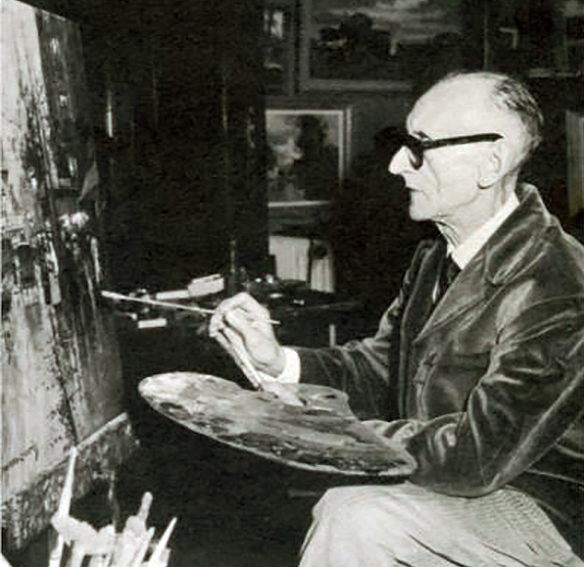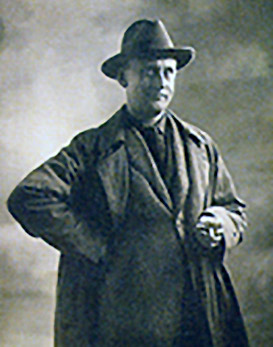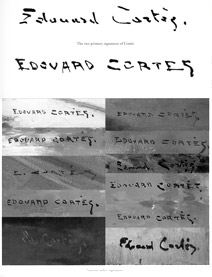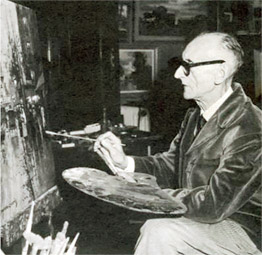Catalogue Raisonne´

Edouard Leon Cortès
Biography
“I was born from and for painting…” Èdouard Cortès
Èdouard Leon Cortès was born in Lagny, France on August 6, 1882 into a family of artists and artisans. His birth certificate recorded the child as Èdouard Leon Cortès, but at the age of six weeks he was baptized Henri Èdouard Cortès. He would use the name Henri for several years signing his early paintings Henri, Henri Èdouard or Èdouard H. After the death of his father in 1908, Cortès would revert to using Èdouard. After 1910, Cortès signed his paintings Èdouard Cortès, Ed Cortès or simply E. Cortès
Cortès' father, Antonio Cortès, who was born is Seville, Spain was a successful painter for the royal court in Spain. In 1855, Antonio traveled to Paris to attend the Exposition Universelle and fell in love with the French people and countryside. He would remain is Paris.
 While in the city, Antonio would marry his first wife, Angéline Cécile Berger. They would have a son André, who was born in Paris. Shortly after the birth of their son in 1866, Antonio and his young family would leave Paris to settle in Lagny, a small village east of Paris in Seine-er-Marne region where he would open a studio and became recognized as a painter of country scenes and farm animals.
While in the city, Antonio would marry his first wife, Angéline Cécile Berger. They would have a son André, who was born in Paris. Shortly after the birth of their son in 1866, Antonio and his young family would leave Paris to settle in Lagny, a small village east of Paris in Seine-er-Marne region where he would open a studio and became recognized as a painter of country scenes and farm animals.
In 1870 at the pinnacle of the Franco-Prussian War and the death of Angéline, Antonio and his son would move back to the safety of the city to escape the perils of the war. In 1872, Antonio married Lagny dressmaker Léontine Augustine Frappart. They had two children, Jeanne and Èdouard. All three children followed their father to pursue a career as a painter. André, the oldest, was primarily an accomplished painter of horses. His younger sister Jeanne, like her father, painted pastoral scenes of farm yards and flocks of sheep. She was also a member of the Union Artistique et Littéraire du Canton de Lagny, which was formed as a result of their brother André's death in 1898
Èdouard, the youngest of the siblings, exhibited an exceptional artistic talent. Cortès attended a private elementary school until the age of 13. Upon leaving school, he listed himself in the local census as “artist-painter” and his nationality as Spanish, probably as a tribute to his father.
Èdouard Cortès would continue his artistic training at his father’s Lagny studio receiving encouragement from his brother, sister and local artists. For centuries, Lagny was a magnet for artists, who were attracted to the light, lush landscapes and the Marne. Eugene Isabey, Charles Jean Jacque, Henri Lebasque and Camille Pissarro along with others painted in and around Lagny. The presents of these artists working in the most up-to-date methods and style were a major influence on Cortès growth as a painter. However, the greatest influence would come from his father and Barbizon painters Constant Troyon and Henri Harpignies.
 In 1899, at the age of 16, Èdouard Cortès exhibited his first work at the Société des Artistes Français entitled La Labour, of a farmer driving a horse-drawn plow with a god by his side, which revealed the influence of his father’s animal paintings. The work was well received by the critics and the public - helping establish Edouard’s favorable reputation in Paris. The press in the French capital awarded this young prodigy status of a legend and placed crowns of victory upon his head. Everyone spoke of and discussed the young Henri Cortès.
In 1899, at the age of 16, Èdouard Cortès exhibited his first work at the Société des Artistes Français entitled La Labour, of a farmer driving a horse-drawn plow with a god by his side, which revealed the influence of his father’s animal paintings. The work was well received by the critics and the public - helping establish Edouard’s favorable reputation in Paris. The press in the French capital awarded this young prodigy status of a legend and placed crowns of victory upon his head. Everyone spoke of and discussed the young Henri Cortès.
“I do nothing but paint. I stand in front of my easel at around eight in the morning; from twelve to two I eat lunch and rest, and I paint in the afternoon till dusk, because I don’t like artificial light. That gives me eight to ten hours a day to paint”...Èdouard Cortès
“As long as I am able to get up and go to my easel, I will paint. Until my last breath, because I was born from and for painting, and I will die happy if I am in front of my easel” ...Èdouard Cortès
Cortès would continue to live with his parents in Lagny until just after the death of his father in 1908. He and his mother would then move into a house and studio originally built for Cavallo-Peduzzi at 22 rue Macheret. Except for a few years in Paris and Normandy, Cortès spent most of his life living at 22 rue Macheret and working in his studio.
Édouard married Fernande Joyeuse in 1914 and had a child - Jacqueline Simone in 1916. The First World War would interrupt the life of this young family. Although a pacifist, Èdouard Cortès would join the French military at the age of 32. He was sent to the front lines as a contract agent. Sustaining a bayonet wound, Cortès would be evacuated to a military hospital. He was awarded the Croix de Guerre. Once recovered, Èdouard Cortès was assigned to a staff position, where his artistic talents proved invaluable in sketching enemy positions. After the war, Cortès became even more pacifist in his convictions and refused to accept the Légion d'Honneur when it was offered by the French government.
In 1919, Èdouard Cortès was demobilized and retuned to Paris. His wife, Fernande would die in 1918 leaving Cortès and his two year old daughter, Jacqueline, alone. Shortly thereafter Édouard would marry his sister-in-law Lucienne Joyeuse. They settled in Paris and Édouard continued to paint views of Paris.
In 1925, Cortès moved his family moved back to Lagny (in Normandy) and he began painting scenes of country life - including landscapes, interior scenes and still lives. Later Cortes bought a second home in Normandy village of Quistreham where he spent much of his time painting between 1935 and 1941.
After returning to Lagny, Èdouard Cortès became an active member of the Union des Beaux-Arts de Lagny and was the Unions first president. Their inaugural exhibition was held in 1927. Cortès continued to exhibit at the Union until the late 1930's. During this period he received many awards, gained great notoriety and was a frequent exhibitor at the exhibition halls in Paris, including the Salon d'Automne, Salon d'Hiver, Salon de la Société Nationale de l'Horticulture and Salon des Indépendants.
During the years of World War II, Cortès and his family spent their time in Cormelles-le-Royal (in Normandy) in an attempt to remove themselves from the harsh realities of war. In 1954, Èdouard Cortès had relocated to Lagny, where he passed his life in a simple manner among a small circle of friends.
Edouard Cortès continued to paint mastering several mediums (oil, gouache, watercolor and pastel) to execute his exquisite variations of his primary theme: the beauty of Paris. When asked why his works stilled showed horse-drawn carriages, omnibuses and fashions from before 1930, Cortès commented that he wished to stop history in 1939 before the Second World War His paintings by now were in demand all over the world. Èdouard Cortès achieved special success in the United States and Canada, where he had first exhibited in 1945.
“I had a good fortune to inherit some talent, and also to have been taught by my father. If my paintings please those who view them and if they give a feeling of places and moments, or waken curiosity about the history of a monument of a place, then I am fully satisfied with my success.”... Edouard Cortès
 Edouard Cortès was an extremely modest man. He refused all interviews, cared nothing about documenting his career, and even declined in 1955 to be the subject of an hour-long filmed documentary. He preferred to remain anonymous as an individual to allow his painting to speak for themselves by standing on their own merit. In the last years of his life, Èdouard Cortès received homage from the Salon de Vincennes, where he was one of 117 exhibitors. The Salon awarded him the prestigious Prix Antoine-Quinson. 28, 1969 in his home at 22 rue Macheret, Lagny-Torigny. He passed away the way he lived in serenity and simplicity. Although he did not wish the town of Lagny to celebrate his life, ten years after his death a street was name in his honor.
Edouard Cortès was an extremely modest man. He refused all interviews, cared nothing about documenting his career, and even declined in 1955 to be the subject of an hour-long filmed documentary. He preferred to remain anonymous as an individual to allow his painting to speak for themselves by standing on their own merit. In the last years of his life, Èdouard Cortès received homage from the Salon de Vincennes, where he was one of 117 exhibitors. The Salon awarded him the prestigious Prix Antoine-Quinson. 28, 1969 in his home at 22 rue Macheret, Lagny-Torigny. He passed away the way he lived in serenity and simplicity. Although he did not wish the town of Lagny to celebrate his life, ten years after his death a street was name in his honor.
Èdouard Leon Cortès passed away in 1969 in his home at 22 rue Macheret, Lagny-Torigny the same way he lived his life in serenity and simplicity. Although he did not wish the town of Lagny to celebrate his life, ten years after his death a street was name in his honor.
His paintings are exhibited in the museums of France and many other foreign countries, including Belgium, England, Switzerland, Sweden and Canada.
Principle Art Exhibitions
- Principaux Salons
- Salon des Artistes Francais
- Salon de l’Union Artistique et Litt´raire de Lagny
- Salon de l’Ecole Française
- Salon d’Hiver
- Salon d’Automne
- Salon des Indèpendants
- Salon de l’Union des Beaux-Arts de Lagny
Expositions
- Arras
- Auxerre
- Avallon
- Beauvais
- Caen
- Calais
- Cannes
- Chelles
View Artist Paintings »